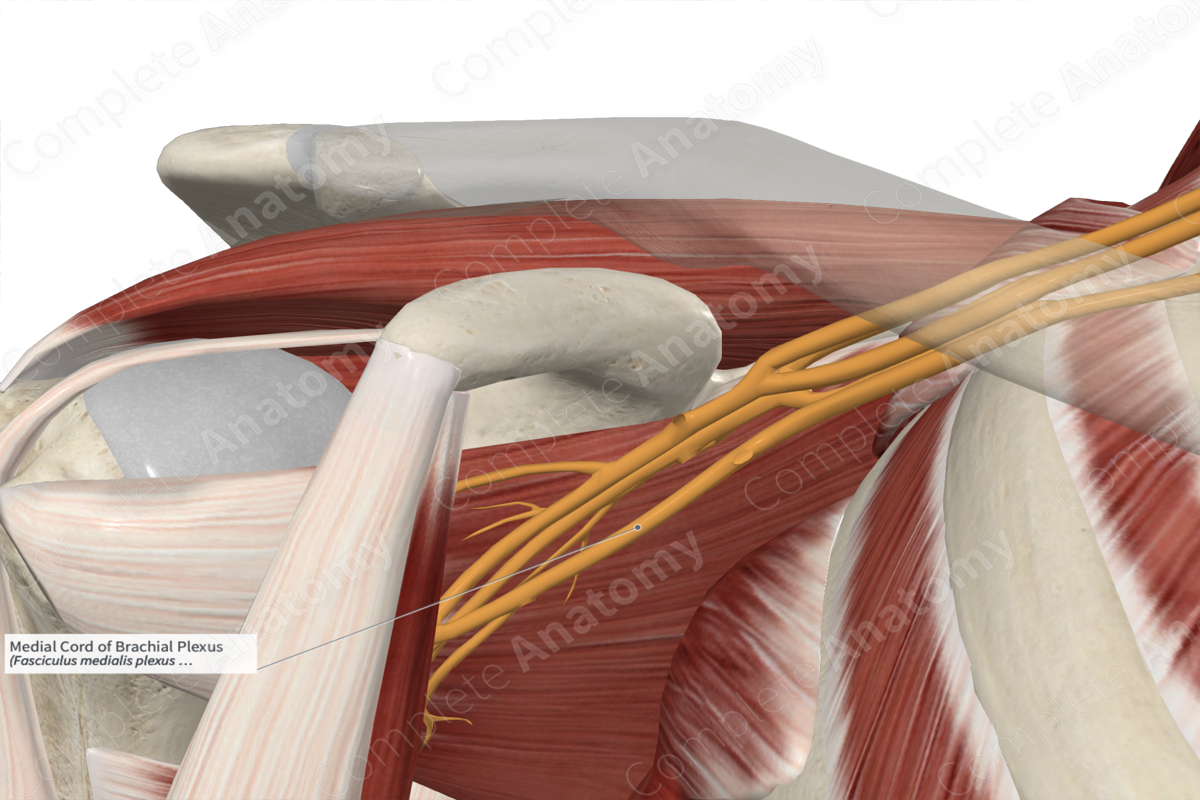
Medial Cord of Brachial Plexus Quick Facts
Origin: Anterior division of the inferior trunk of the brachial plexus.
Course: Run inferolaterally within the axilla, medial to the axillary artery.
Branches: Medial pectoral nerve, medial branchial cutaneous nerve, medial antebrachial cutaneous nerve, ulnar nerve, medial half of the median nerve.
Supply: Sensory and motor innervation. Supplies sensory innervation for the skin of the palmar and medial surfaces of the hand, the tips of the digits, and the anteromedial surfaces of the arm and forearm. Motor innervation is to the muscles of the hand, anterior compartment muscles of the forearm, and pectoralis muscles.
Related parts of the anatomy
Medial Cord of Brachial Plexus Origin
The origin of the medial cord is from the anterior division of the inferior trunk. It carries fibers from the C8 and T1 spinal segments.
Medial Cord of Brachial Plexus Course
From its origin roughly lateral to the first rib, the posterior cord runs inferolaterally through the axilla. It is originally posterior to the first segment of the axillary artery, but by the second segment, it has assumed a position medial to the axillary artery.
The medial cord gives off three branches adjacent to the second segment of the axillary artery. It then continues down along the axillary artery until it terminates in the lower axilla, medial to the third segment of the axillary artery.
The cords of the brachial plexus run within the axillary sheath which is an inferior extension of the prevertebral fascia.
Medial Cord of Brachial Plexus Branches
The medial cord gives rise to the following nerves:
—medial pectoral nerve;
—medial branchial cutaneous nerve;
—medial antebrachial cutaneous nerve;
—ulnar nerve;
—medial half of the median nerve.
Although typically considered a branch of the medial cord, reports from cadaveric investigations suggest that in a majority of cases, the medial pectoral nerve may originate from the distal end of the anterior division of the inferior trunk (Loukas et al., 2006).
Medial Cord of Brachial Plexus Supplied Structures
The medial cord conveys both sensory and motor innervation. This includes anterior and medial surfaces of the arm, forearm, hand, and fingers (sensory) and the muscles of the hand, anterior compartment of the forearm, and pectoralis muscles (motor). Broken down by nerve, the structures supplied by the anterior division of the inferior trunk are:
—medial pectoral nerve supplies the pectoralis minor and pectoralis major muscles;
—medial brachial cutaneous nerve supplies skin of the medial arm;
—medial antebrachial cutaneous nerve supplies skin of the anterior and medial forearm;
—ulnar nerve supplies skin of the medial surface of the hand and all intrinsic muscles of the hand and forearm flexors not innervated by the median nerve;
—median nerve supplies skin of the lateral palmar surface of the hand and finger tips and all intrinsic muscles of the hand and forearm flexors not innervated by the ulnar nerve.
Medial Cord of Brachial Plexus References
Loukas, M., Louis, R. G., Fitzsimmons, J. and Colborn, G. (2006) 'The surgical anatomy of the ansa pectoralis', Clin Anat, 19(8), pp. 685-93.
Learn more about this topic from other Elsevier products
Brachial Plexus

Neonatal brachial plexus palsy (NBPP) can be defined as a flaccid paresis of an upper extremity due to traumatic stretching of the brachial plexus, with the passive range of motion greater than the active.




